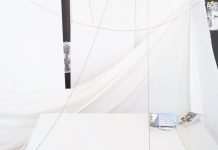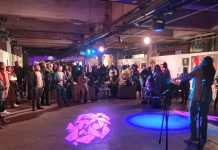
Many creative types know that the “starving artist” cliche exists for a reason; this is not an easy way to make a living. But twenty-seven-year-old Jessica Caldas is defying the stereotype and recently was able to leave her day job at the Atlanta Volunteer Lawyers Foundation to focus on her art career full time.
Caldas, who graduated from the University of Georgia in 2012 with a BFA in printmaking, snagged the 2014 Emerging Artist Award in visual arts from the Atlanta Office of Cultural Affairs, and she is staying busy with several current and upcoming projects, including a Walthall Fellowship presented by the WonderRoot community arts organization.
Born in Jacksonville, Florida, Caldas grew up in Atlanta after moving here at the age of two. Surrounded by a family full of creative people, she says that art always seemed like a natural—and attainable—career path. Her work deals primarily with social justice and issues like domestic violence, which disproportionately affects females. “After studying at UGA, I was very interested in various types of human relationships and how they work,” she says. She began pursuing personal stories about domestic violence to help herself and others understand it. “It’s easier for people to connect to an issue through the lens of a personal narrative,” she says.
Caldas draws on her own narrative, too. Candid about her struggles with alcoholism, she created the piece “Back on My Feet,” inspired by her experience with the nonprofit of that name, which uses running to help homeless people gain self-sufficiency. “When you’re running together, you don’t know who’s who, who is homeless or not,” she says. “The truth is, I have a lot of the same problems as them. Some of the participants struggle with addiction, and I’m an alcoholic who has been sober for over a year. The only thing that makes it different is that I had access to resources like support groups and family support.”
View Caldas’s work at jessicacaldas.com.
What led you to a career in art?
As long as I can remember, I was one of those kids who was always drawing. I would draw a lot for friends—not just doodles, but actual portraits—and at some point I started to gather that maybe I was better at this drawing thing than other people are. I also come from a very creative family: My dad, brother, and sister draw too, my mom is very crafty, and my grandfather is a painter. I was always surrounded by creativity, so I always knew that I wanted to be—and could be—an artist, in addition to anything else I might choose to do.
What’s it like to be a full-time artist now?
One of the best parts of going full-time is that now I have time and space to explore in ways I didn’t before. I go to the studio a lot more, but it’s not just that: I have time to do more research for projects, and I have the freedom to meet other artists and people in the community, to sit down and have a cup of coffee. My artistic presence isn’t just about sitting in the studio doing art. It’s very important for me to be involved in the community too. I’m very serious about the commitment. If I’m not involved in a particular community, then I probably shouldn’t be making art about it.
What is an example of one of your projects in which community played a large role?
I did a project for Elevate in 2012 called the Back on My Feet project, centered around the nonprofit of the same name, which uses running as a catalyst for transient populations. Residents from three different homeless shelters go running three times a week at 5:30 a.m., and it’s one of the coolest things I’ve ever done. When you’re running together, you don’t know who’s who, who is homeless or not. The truth is I have a lot of the same problems as them. Some of the participants struggle with addiction, and I’m an alcoholic who has been sober for over a year. The only thing that makes it different is that I had access to resources like support groups and family support. Through that program, I met a guy participant named Avien who wrote poetry for the project, and we’re talking about collaborating again.
What are your thoughts about Atlanta’s art scene?
I still feel like such a baby sometimes in the Atlanta art scene, but everyone is really nice and supportive. Lots of organizations and people are trying to help each other out, even though some of us are competing against each other. The city does a great job, but for what Atlanta lacks in funding, there are a lot of organizations and foundations trying to make up for it. I don’t know what it’s like to be an artist in another city, so I can only speak from my experience, but it’s easy to be an artist in Atlanta—I can afford to live here and still make art. I feel like I can accomplish what I want here and don’t feel the need to move to New York to make things happen, and it’s even better because of the lower cost of living. There are a lot of young organizations in Atlanta that are really reaching far, making waves nationally and internationally, which is cool to see. Atlanta has clout, and we should take ourselves seriously.
A version of this story originally appeared in our May 2014 issue.















